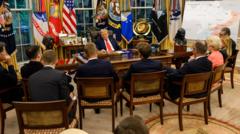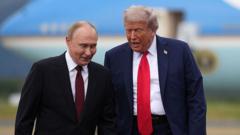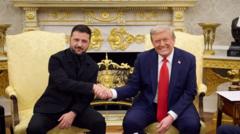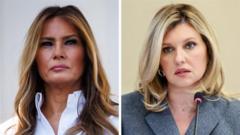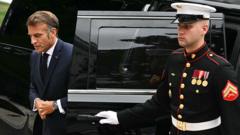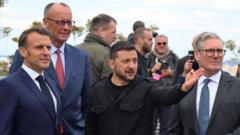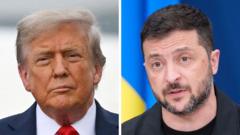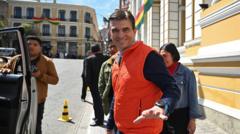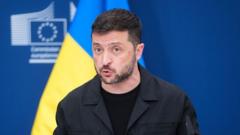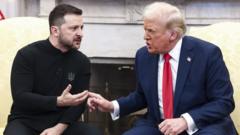Despite two recent summits held by Donald Trump aimed at pushing for peace in Ukraine, tangible progress is notably lacking. Trump met with Vladimir Putin in Alaska last Friday, followed by an urgent meeting with six European leaders in Washington, D.C., on Monday. While both gatherings carried significant diplomatic weight, the concrete outcomes were scarce, prompting pressure on Trump to fulfill his pledge to end foreign military entanglements.
### Trump Faces Challenges in Pursuit of Ukrainian Peace After Recent Summits
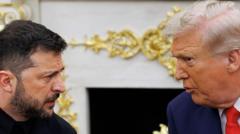
### Trump Faces Challenges in Pursuit of Ukrainian Peace After Recent Summits
Former President Trump meets with European leaders post-summit as the quest for peace in Ukraine remains fraught with difficulty.
During the White House meeting, Trump entertained the idea of providing U.S. security assurances for Ukraine conditional on a peace agreement, a move seen by Ukrainian and European officials as pivotal for sustainable peace. However, he clarified that any commitment might involve "air support" rather than ground troops, and insisted that Europe must bear most of the logistical burden.
Trump also mentioned the potential for a meeting between Putin and Ukrainian President Zelensky, though specifics remain unclear, and European leaders are demanding a ceasefire prior to any negotiations—something Trump suggested might be unlikely. Nonetheless, the fact that the meetings were conducted in a cooperative atmosphere marks a significant improvement compared to prior interactions between Trump and Zelensky.
Trump's ambition to carve out a peace deal in Ukraine is underscored by his comments indicating he sees success in this area as vital to securing his legacy. Yet the complexities of the situation loom large, particularly as skepticism remains about Putin's willingness to pursue peace amidst continued military operations in Ukraine.
While Trump has reportedly expressed confidence in Putin's desire to negotiate, his inconsistent approach to foreign relations leads many to question the reliability of any commitments made during this time. European leaders’ hurried visit to D.C. seems to reflect their urgency in securing U.S. backing while mitigating influence from Russia.
Moreover, Trump's political base, which favors a more isolationist stance, complicates any plans for increased U.S. involvement in Ukraine. Any security commitments or military resources required to facilitate a peace agreement could face backlash from his supporters, who prioritize domestic issues.
Despite some progress and a palpable desire for peace, the fundamental challenge remains: Trump's interest may not align with those of Ukraine, Russia, or Europe, leaving open the possibility that he might walk away from negotiations altogether.
With multiple factors at play, including opinions from U.S. political circles and European leaders, the path ahead for peace in Ukraine is fraught with uncertainty as Trump navigates the delicate geopolitical landscape.
Follow Anthony Zurcher for more insights into the evolving political landscape surrounding the Ukraine conflict and Trump's presidency.
Trump also mentioned the potential for a meeting between Putin and Ukrainian President Zelensky, though specifics remain unclear, and European leaders are demanding a ceasefire prior to any negotiations—something Trump suggested might be unlikely. Nonetheless, the fact that the meetings were conducted in a cooperative atmosphere marks a significant improvement compared to prior interactions between Trump and Zelensky.
Trump's ambition to carve out a peace deal in Ukraine is underscored by his comments indicating he sees success in this area as vital to securing his legacy. Yet the complexities of the situation loom large, particularly as skepticism remains about Putin's willingness to pursue peace amidst continued military operations in Ukraine.
While Trump has reportedly expressed confidence in Putin's desire to negotiate, his inconsistent approach to foreign relations leads many to question the reliability of any commitments made during this time. European leaders’ hurried visit to D.C. seems to reflect their urgency in securing U.S. backing while mitigating influence from Russia.
Moreover, Trump's political base, which favors a more isolationist stance, complicates any plans for increased U.S. involvement in Ukraine. Any security commitments or military resources required to facilitate a peace agreement could face backlash from his supporters, who prioritize domestic issues.
Despite some progress and a palpable desire for peace, the fundamental challenge remains: Trump's interest may not align with those of Ukraine, Russia, or Europe, leaving open the possibility that he might walk away from negotiations altogether.
With multiple factors at play, including opinions from U.S. political circles and European leaders, the path ahead for peace in Ukraine is fraught with uncertainty as Trump navigates the delicate geopolitical landscape.
Follow Anthony Zurcher for more insights into the evolving political landscape surrounding the Ukraine conflict and Trump's presidency.

